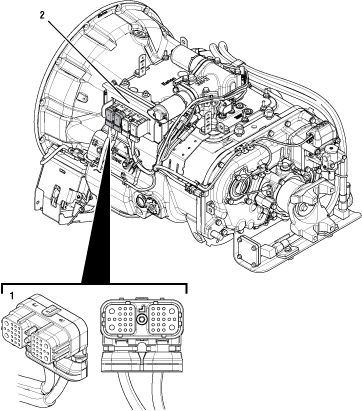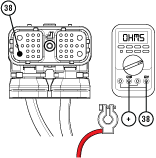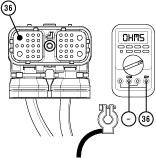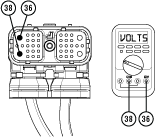Fault Code 33: Low Battery Voltage Supply
J1587: MID 130 PID 168 FMI 4
J1939: SA 3 SPN 168 FMI 4
Overview
Fault Code 33 sets Active if battery voltage to the TECU falls below 7 volts for more than 1 second.
Detection
The Transmission Electronic Control Unit (TECU) monitors the battery voltage supplied to the TECU after completing power up. Fault Code 33 sets Active if battery voltage to the TECU falls below 7 volts for more than 1 second. Fault Code 33 represents a more severe drop in battery voltage than Fault Code 34, Weak Battery Voltage Supply, which sets Active below 9 volts.
Conditions to Set Fault Code Active
FMI 4 – Voltage Below Normal or Shorted Low: TECU monitors battery voltage of the vehicle. If the voltage falls below 7 volts for more than 1 second, the fault sets Active.
Fallback
FMI 4
- “F” flashes in gear display.
- Service light flashes (if equipped).
- Engine may not crank.
- Transmission may not engage a gear from neutral.
- Transmission may not attempt to shift.
- Until the fault becomes Inactive, driver may have to shut off engine with transmission in gear.
Conditions to Set Fault Code Inactive
FMI 4: Battery voltage stays at 7 volts or greater for more than 1 second.
Possible Causes
FMI 4
- Vehicle Power Supply
- Wiring shorted to ground, shorted to power or open
- Terminals bent, spread, corroded or loose
- In-line fuse corrosion, loose connection or blown fuse
- Vehicle Batteries
- Internal failure
- Vehicle Charging System
- Charging system failed
- TECU
- Internal failure
Component Identification
 |
1. 38-Way Vehicle Harness Connector 2. Transmission Electronic Control Unit (TECU) |
Fault Code 33 Troubleshooting
Key off.
NoticeMeasure voltage across all batteries. Record voltage in table.
Inspect Starter, battery terminals and transmission 30-amp In-line Fuse Holder Connections for corrosion, loose terminals and bent or spread pins.
If any issues are found with connectors, refer to OEM guidelines for repair or replacement of Vehicle Harness wiring. Go to Step V
If corrosion or other damage is visible at the battery terminals, refer to OEM guidelines for repair or replacement of batteries. Go to Step V
If no issues are found, Go to Step B
| Battery Voltage |
|---|
Key off.
Load test each vehicle battery per OEM specifications. Record reading(s) in table.
If all batteries pass the Load Test, Go to Step C
If any battery does not pass the Load Test, refer to OEM guidelines for repair or replacement of batteries. Go to Step V
| Battery | Voltage Drop | Load Test Status (Pass/Fail) |
|---|---|---|
| 1 | ||
| 2 | ||
| 3 | ||
| 4 | ||
| 5 |
Record the transmission fault codes, FMIs, occurrences, and timestamps from the Service Activity Report created during the Diagnostic Procedure.
If Fault Code 33 is Active, Go to Step F
If Fault Code 33 is Inactive, Go to Step D
Set parking brake and chock wheels.
Place transmission in PD Mode. See more about Product Diagnostic (PD) Mode.
Note: Transmission does not enter PD Mode when Active fault codes exist.

Wiggle wiring and connections of the Vehicle Harness from the batteries to the TECU. Look for signs of pinched or chafed wiring. Verify all connections are clean and tight.
Exit PD Mode by powering down.
Notice
If any fault code sets Active while wiggling the Vehicle Harness, refer to OEM guidelines for repair or replacement of Vehicle Harness wiring. Go to Step V
If no fault codes set Active, Go to Step E
Key off.
Disconnect 38-Way Vehicle Harness Connector from TECU.
Inspect connector body for corrosion and damage, and loose, spread or bent terminals.
Disconnect Battery Positive (+) and Negative (-) connections.
Measure resistance between 38-Way Connector Pin 38 and Battery Positive (+) connection. Record reading(s) in table.

Measure resistance between 38-Way Connector Pin 36 and Battery Negative (-) connection. Record reading(s) in table.

Compare reading(s) in table.
If readings are in range, no problem was identified. Test complete. If additional troubleshooting is required, contact the OEM for additional diagnosis of the Vehicle Power Supply Harness. Go to Step V
If readings are out of range, repair or replace damaged wiring per OEM guidelines. Go to Step V
| Pins | Range | Reading(s) |
|---|---|---|
| 38 to Battery Positive (+) | 0.0–0.3 ohms | |
| 36 to Battery Negative (-) | 0.0–0.3 ohms |
Key off.
Disconnect 38-Way Vehicle Harness Connector from TECU.
Inspect connector body for corrosion, damage, loose, spread or bent terminals.
Key on with engine off.
Measure voltage between 38-Way Connector Pin 38 and Pin 36. Record reading(s) in table.

Compare reading(s) in table.
If readings are in range, Go to Step G
If readings are out of range, refer to OEM guidelines for repair or replacement of 38-Way Vehicle Harness. Go to Step V
| Pins | Range | Reading(s) |
|---|---|---|
| 38 to 36 | Within 1.2 V of Battery Voltage (Step A) |
Key off.
Reconnect all connectors and verify that all components are properly installed.
Key on with engine off.
Connect ServiceRanger and check fault codes.
If Fault Code 33 remains Active with all connections re-established, replace Transmission Electronic Control Unit (TECU). Go to Step V
If Fault Code 33 is now Inactive with all connections re-established, refer to OEM guidelines for repair or replacement of Vehicle Harness wiring. Go to Step V
Key off.
Reconnect all connectors and verify that all components are properly installed.
Key on with engine off.
Clear fault codes using ServiceRanger.
Drive vehicle and attempt to reset the code or duplicate the previous complaint.
Check for fault codes using ServiceRanger.
If no fault codes set Active and vehicle operates properly, test complete.
If Fault Codes 33 or 34 sets Active during the test drive, Go to Step A
If a fault code other than 33 or 34 sets, troubleshoot per Fault Code Isolation Procedure Index.